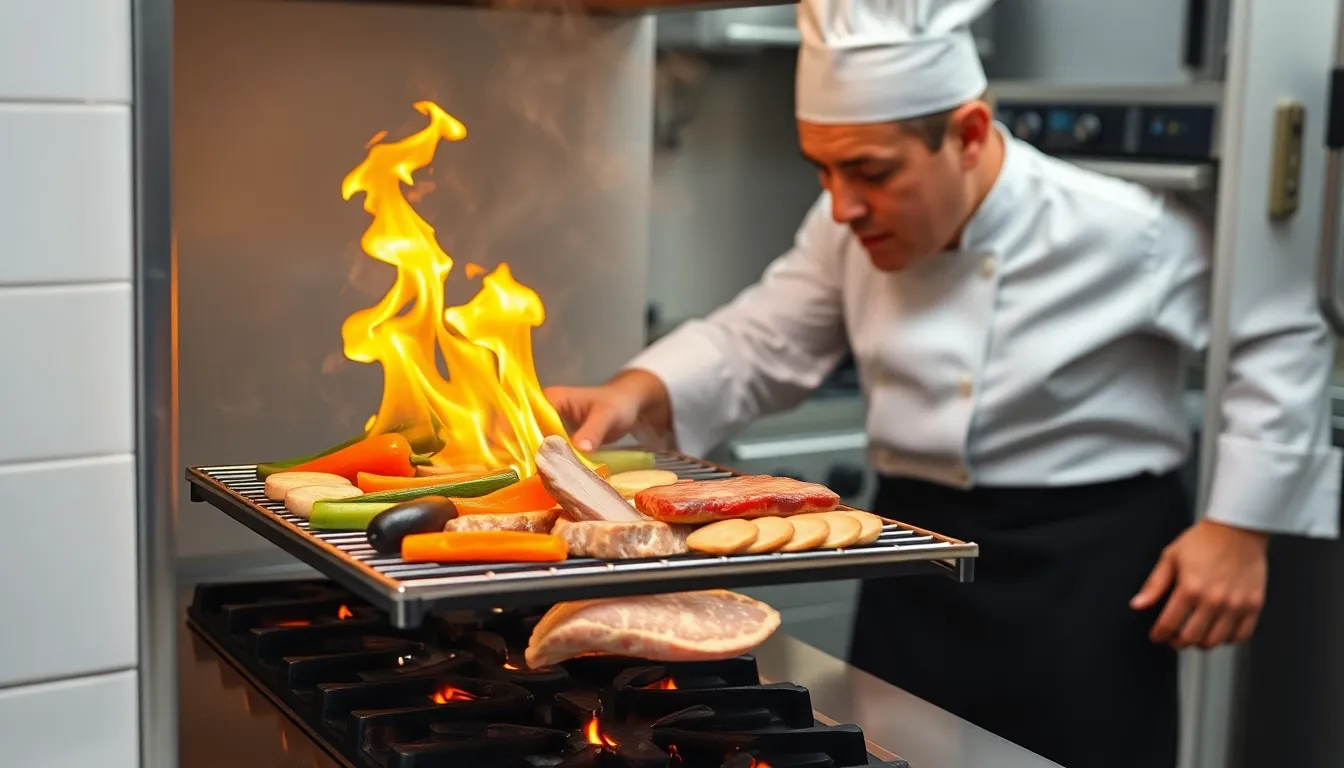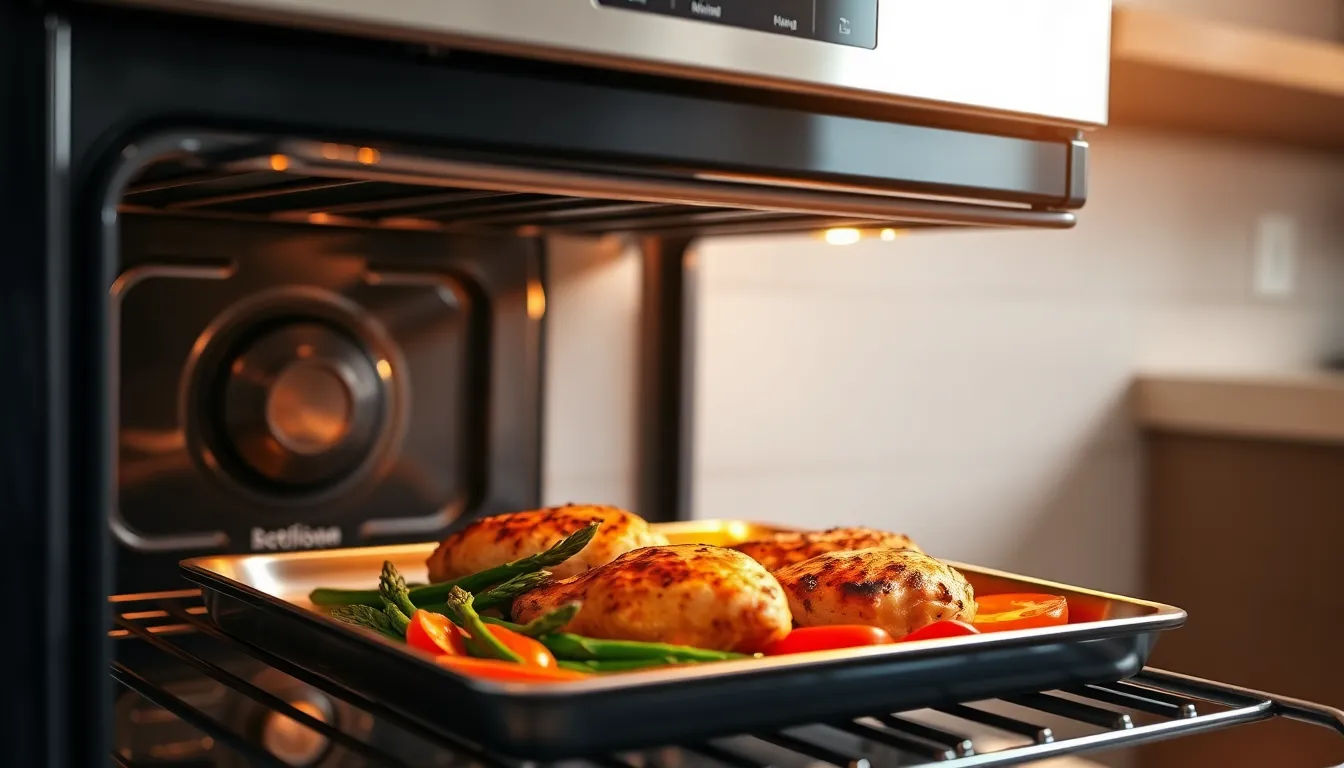Table of Contents
ToggleWhen it comes to cooking, the oven can feel like a mysterious contraption, especially when it comes to that little button labeled “broil.” What does it even mean? Is it a fancy way to say “burn everything to a crisp”? Not quite! Broiling is actually a culinary superpower that can transform meals from mundane to mouthwatering in minutes.
Understanding Broiling
Broiling represents a high-heat cooking method suitable for quickly cooking food, often from above. Several foods benefit from this technique, including meats and vegetables.
Definition of Broiling
Broiling refers to a cooking process that exposes food to direct heat. The primary heat source comes from above, typically from an oven’s broiler element. Chefs often use this method to achieve a caramelized crust on dishes, unlocking rich flavors and enticing textures.
How Broiling Works
Broiling works by utilizing intense direct heat that enhances browning. Food placed close to the heat source cooks rapidly, making it crucial to monitor cooking times. Heat distribution is designed to create a sizzle upon contact with food, producing a pleasant aroma. Understanding distance to the heating element is vital; adjusting this distance controls cooking speed and doneness.
Benefits of Broiling

Broiling offers several advantages, making it a popular cooking technique among home cooks and chefs alike.
Health Advantages
Broiling promotes healthier cooking by allowing excess fats to drip away from food. This method reduces calorie content while retaining essential nutrients within the ingredients. Lean cuts of meat, fish, and vegetables benefit from broiling, as this technique minimizes the need for oils and additives. Cooked food often contains fewer unhealthy substances, contributing to better overall health. Broiling retains natural flavors, enhancing the eating experience without compromising dietary goals.
Time Efficiency
Broiling cooks food quickly, making it a time-saving option in meal preparation. High heat reduces cooking times, allowing meals to be ready in as little as 10 to 20 minutes. Chefs often rely on broiling for quickly preparing intricate dishes, as it effectively caramelizes and browns surfaces in a short period. This quick cooking method aids busy individuals and families seeking nutritious meals without lengthy preparation times. The efficiency of broiling enhances meal planning and ensures that delicious food is accessible without effort.
Cooking Techniques for Broiling
Broiling offers a simple and effective way to prepare a variety of dishes quickly. This technique thrives on high heat and direct exposure, yielding beautifully caramelized foods.
Recommended Foods for Broiling
Fish works wonderfully when broiled, as it cooks quickly and retains moisture. Chicken breasts benefit from broiling, resulting in juicy interiors and crispy skin. Vegetables like asparagus and bell peppers also shine under the broiler, developing a charred flavor profile. Cut meats, such as steaks and pork chops, deliver robust taste when broiled, highlighting their natural juices. These recommended foods perform exceptionally well, making broiling an ideal cooking method for delicious meals.
Broiling Tips and Tricks
Position food closer to the broiler for a faster cooking time. Use a broiler pan to allow fat to drain away, promoting healthier meals. Adjust the cooking time based on the thickness of the food for perfect doneness. Preheating the broiler ensures even heat distribution and reduces cooking time. Keep a close eye on the food to avoid burning, as high heat can make cooking times fluctuate. These tips enhance the broiling process, ensuring delicious results every time.
Common Mistakes to Avoid
Several common mistakes arise when broiling in the oven. Avoiding these pitfalls enhances cooking results and ensures flavorful meals.
Overcooking Issues
Overcooking often occurs due to lack of attention. Monitoring food closely during the broiling process prevents undesired charred outcomes. Timing plays a crucial role; thicker cuts of meat require more time versus thinner options. Using a meat thermometer provides a reliable way to gauge doneness. Remaining aware of the broiler’s intensity helps achieve the perfect balance between cooking and charring, maintaining a delicious flavor.
Incorrect Oven Settings
Selecting the wrong oven setting can lead to unsatisfactory results. Utilizing the correct broil function ensures proper cooking dynamics. Some ovens have multiple broil settings—high or low. Choosing the right one based on food type is essential. Consulting the owner’s manual provides clarity on available settings. Additionally, selecting the right rack position places food at the appropriate distance from the heating element, promoting even cooking.
Broiling is a powerful cooking technique that offers numerous benefits for those looking to prepare flavorful meals quickly. With its ability to enhance textures and caramelize surfaces, broiling transforms ordinary ingredients into culinary delights. This method not only promotes healthier eating by allowing excess fats to drip away but also saves time in the kitchen.
By mastering the art of broiling and avoiding common pitfalls, cooks can elevate their dishes and create a variety of delicious meals. Whether it’s a perfectly seared steak or vibrant roasted vegetables, broiling proves to be an invaluable tool for any home chef. Embracing this technique can lead to a more enjoyable cooking experience and a healthier lifestyle.




